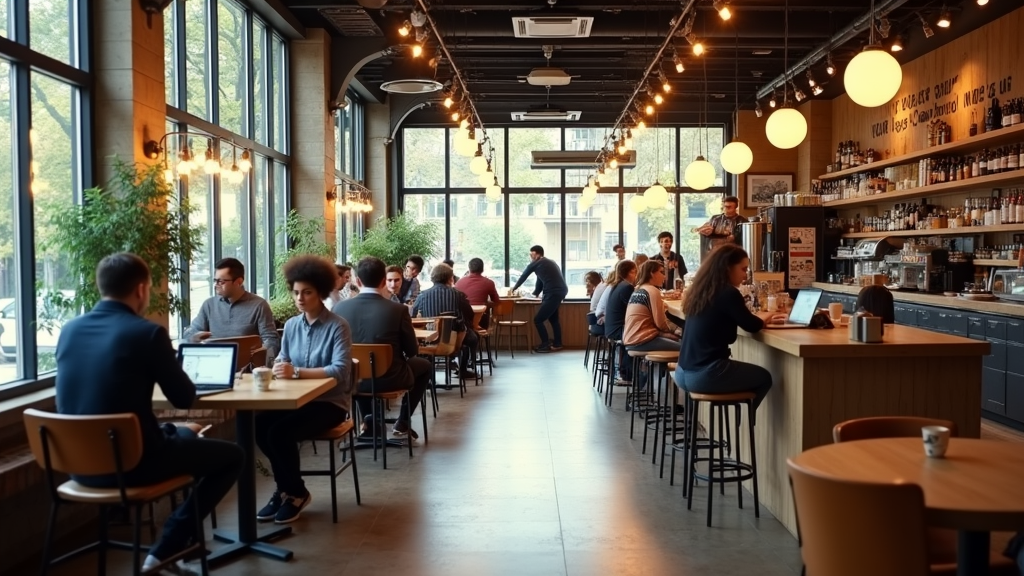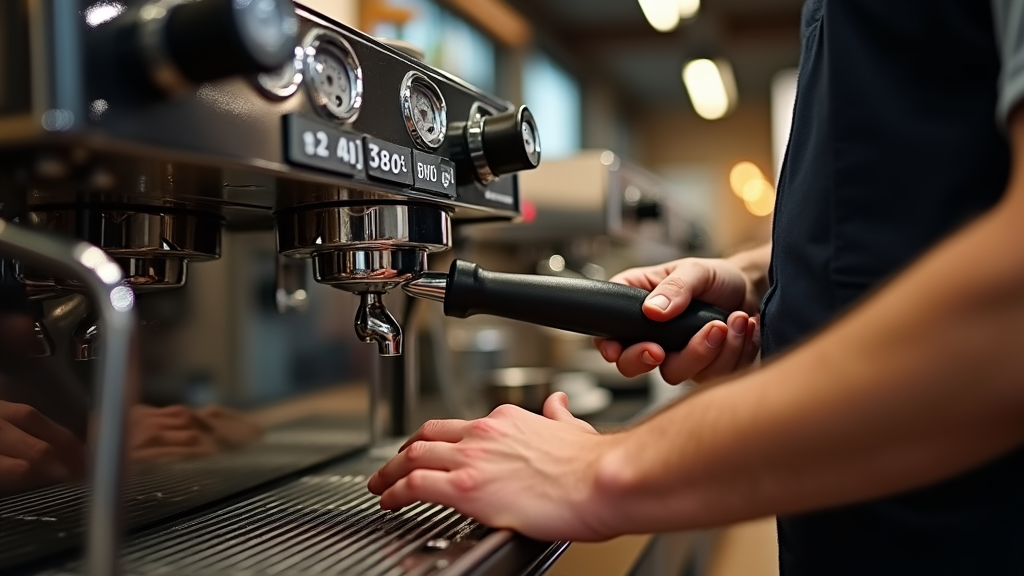
Why Open a Coffee Shop
The coffee industry continues to show impressive growth as more people make daily coffee purchases part of their routine. Your local market likely has room for a new coffee shop, since coffee consumption keeps rising across all age groups.
Many people think coffee shops are too risky or that big chains make it impossible for small shops to succeed. The truth is that independent coffee shops often have lower startup costs than other food businesses. You can start small and grow based on customer demand.
The specialty coffee market gives you unique ways to stand out from the competition. You can create a special place in your community by focusing on high-quality beans and building genuine connections with your customers.
Initial Planning
A solid business plan helps you turn your idea into a real business. Your plan works like a map that guides your decisions and helps you spot problems before they happen.
Starting a business needs careful research about your market and who will buy from you. You should know exactly who your customers are and what they want to buy from you. Your plan must also include clear numbers about how much money you'll need and expect to make.
Don't rush your planning just to start selling faster. You should also avoid copying other business plans without thinking about what makes your business different.
Location Matters
Your coffee shop's success starts with picking the right spot where your target customers naturally spend time. Consider factors like nearby businesses, parking availability, and whether the area matches your shop's style.
Many new cafe owners think expensive locations automatically mean better business, but this isn't always true. Lower-rent areas can work great if they have the right mix of residents and workers. What matters most is having quality foot traffic that matches your target customer, not just having lots of random people walking by.
Getting a good deal on your lease means planning ahead and knowing what to ask for. You can often negotiate better terms by offering a longer lease period or showing proof that your business plan is solid.

Equipment Essentials
A reliable espresso machine, commercial grinder, and water filtration system form the backbone of your coffee shop operations. You'll also need basic tools like tampers, milk pitchers, cleaning supplies, and a refrigeration unit for perishables.
You don't need to spend a fortune on top-end equipment to serve excellent coffee. Many mid-range commercial machines can produce drinks that rival those made on luxury equipment, especially when operated by skilled baristas. What matters most is choosing reliable, well-reviewed equipment that matches your shop's size and expected daily output.
Regular cleaning and preventive maintenance will keep your equipment running smoothly for years to come. It's smart to build relationships with local repair technicians and keep basic spare parts on hand to minimize any potential downtime.
Menu Development
A well-balanced coffee shop menu needs both classic drinks like espresso and cappuccino, plus some unique signature beverages that set you apart from competitors. Your menu should also include a selection of food items that pair perfectly with your drinks, from morning pastries to light lunch options.
Setting the right prices for your menu items starts with calculating your exact costs for ingredients, labor, and overhead. Your coffee drinks should maintain a profit margin between 70-80% to keep your business healthy. You can check local coffee shops in your area to ensure your prices stay competitive while maintaining your target margins.
Seasonal menus give you a chance to try new drinks and keep customers excited about visiting your shop. You should plan your seasonal offerings at least 3 months in advance, focusing on flavors and ingredients that match the weather and local events.
Hiring and Training Staff
Finding the right employees starts with looking for people who share your passion for coffee and customer service. You can find great candidates through local job boards, coffee industry forums, and referrals from other coffee professionals.
Running a coffee shop comes with its share of staffing hurdles, like creating balanced work schedules that keep both your business and employees happy. High turnover can hurt your shop's consistency and training investment, but offering competitive pay and clear advancement paths helps keep good staff around. When employees feel stuck in their roles, you can fix this by creating skill-building opportunities and cross-training programs.
A solid training program needs clear steps that cover everything from coffee basics to customer service and safety rules. You can keep your staff growing by mixing hands-on practice with regular feedback sessions and updates on new coffee trends and techniques.

Customer Service Excellence
Your coffee shop's success depends on more than just great coffee - it's about creating memorable experiences through exceptional service. Every interaction with customers is a chance to turn casual visitors into loyal fans who keep coming back.
Common practices like quick service and polite greetings are just the beginning of true customer care. You can create deeper connections by remembering regular customers' names and their usual orders. Building a community means hosting local events, celebrating customer milestones, and making your shop a place where people feel at home.
Customer feedback is your guide to constant improvement, so make it easy for customers to share their thoughts. When you receive feedback, respond quickly and show customers how their input helps shape your service.
Health and Safety
Before you start your food business, you need to get health permits from your local health department. These permits show you meet basic safety standards and must be displayed where customers can see them.
Food safety should be your top priority, starting with proper hand washing and using gloves when handling food. You must store all ingredients at the right temperature and use the FIFO (First In, First Out) method to prevent spoilage. Many businesses face issues with temperature control, cross-contamination, and improper food storage, so you should check these areas regularly.
Your cleaning schedule needs to include daily sanitizing of all food prep surfaces and equipment. You should also set up a pest control program and maintain detailed cleaning logs to show health inspectors during their visits.
Marketing Your Shop
Getting your coffee shop noticed starts with building strong relationships with local businesses and event organizers in your area. Word-of-mouth marketing remains powerful, so encourage happy customers to share their experiences with friends and family.
Social media platforms like Instagram are perfect for showing off your drinks and pastries through beautiful photos. Your customers will love to share pictures of your coffee art and unique drinks with their friends. Building an active social media presence helps you connect with customers, share updates about special offers, and create a community around your brand.
A good loyalty program can turn first-time visitors into regular customers. You can start with a simple digital punch card system that rewards customers with a free drink after buying a certain number of coffees.
Want to learn more marketing tips for your coffee shop? Check out these proven coffee shop marketing strategies that can help grow your business.
Financial Management
Your daily financial tasks need a simple system to track income and expenses accurately. Using basic accounting software helps you record transactions and maintain organized books without spending hours on paperwork.
Many small business owners make three common mistakes: mixing personal and business finances, forgetting to track small expenses, and not setting aside money for taxes. Opening a separate business account helps you avoid confusion and simplifies tax preparation. Keeping all receipts, even for small purchases, gives you a clear picture of your spending habits.
Regular profit monitoring lets you spot trends and make quick adjustments to your business strategy. By setting clear financial goals and reviewing them monthly, you can make informed decisions about when to invest in growth opportunities.
Growth and Scaling
Finding growth opportunities starts with listening to your customers and tracking what they need most from your business. You can spot these opportunities by looking at your sales data and asking your current customers what other products or services they'd like to see.
Many business owners think fast growth equals success, but this often leads to problems. Taking small, planned steps helps you build a stronger business foundation than rushing into new markets or products. Your team needs time to adapt to changes, and your systems need careful updates to handle more customers.
Quality should be your priority even as your business gets bigger. You can keep your standards high by training your team well and regularly checking if your products or services still meet customer expectations.
Common Questions
How much money do I need to start a coffee shop?
Starting a coffee shop typically requires $200,000 to $375,000. This includes equipment, initial inventory, lease deposits, and working capital.
Your biggest expenses will be the espresso machine, grinders, and other essential equipment. You'll also need money for permits, licenses, and initial marketing.
Remember to set aside at least 6 months of operating expenses as a safety buffer. This helps you stay afloat while building your customer base.
How long until I can expect to be profitable?
Most coffee shops take 6-12 months to reach break-even. Full profitability usually comes in the second or third year of operation.
Your path to profit depends on your location, competition, and operating costs. Smart inventory management and efficient staffing can speed up this timeline.
Focus on building regular customers in your first year. Loyal customers who visit daily are worth much more than one-time visitors.
What makes a coffee shop fail?
Poor location choice is the top reason coffee shops fail. A spot with low foot traffic or difficult parking will struggle regardless of coffee quality.
Bad financial management is another common pitfall. Many owners underestimate operating costs and overestimate initial sales.
Staff turnover and inconsistent service can quickly sink a new coffee shop. Your baristas are the face of your business.
How do I compete with large chains?
Focus on creating a unique, local experience that Starbucks can't replicate. Build personal connections with your customers.
Offer something special that sets you apart. This could be house-roasted beans, local pastries, or a cozy atmosphere that feels like home.
Join local business groups and participate in community events. Your neighborhood presence is your advantage over big chains.
Should I franchise or start independent?
Starting independent gives you complete creative control and higher profit potential. You can create your own brand and adjust quickly to local preferences.
Franchising offers proven systems and brand recognition, but comes with ongoing fees and strict rules. You'll typically need more startup capital for a franchise.
Your choice depends on your experience and comfort with risk. Independent shops offer more freedom but require more business know-how.
